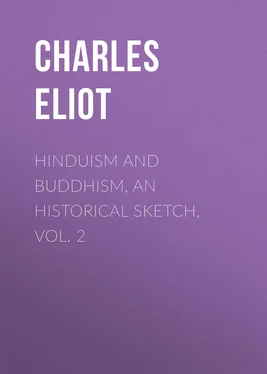Charles Eliot - Hinduism and Buddhism, An Historical Sketch, Vol. 2
Здесь есть возможность читать онлайн «Charles Eliot - Hinduism and Buddhism, An Historical Sketch, Vol. 2» — ознакомительный отрывок электронной книги совершенно бесплатно, а после прочтения отрывка купить полную версию. В некоторых случаях можно слушать аудио, скачать через торрент в формате fb2 и присутствует краткое содержание. Жанр: foreign_religion, Философия, Религиозная литература, foreign_psychology, foreign_antique, foreign_prose, на английском языке. Описание произведения, (предисловие) а так же отзывы посетителей доступны на портале библиотеки ЛибКат.
- Название:Hinduism and Buddhism, An Historical Sketch, Vol. 2
- Автор:
- Жанр:
- Год:неизвестен
- ISBN:нет данных
- Рейтинг книги:4 / 5. Голосов: 1
-
Избранное:Добавить в избранное
- Отзывы:
-
Ваша оценка:
- 80
- 1
- 2
- 3
- 4
- 5
Hinduism and Buddhism, An Historical Sketch, Vol. 2: краткое содержание, описание и аннотация
Предлагаем к чтению аннотацию, описание, краткое содержание или предисловие (зависит от того, что написал сам автор книги «Hinduism and Buddhism, An Historical Sketch, Vol. 2»). Если вы не нашли необходимую информацию о книге — напишите в комментариях, мы постараемся отыскать её.
Hinduism and Buddhism, An Historical Sketch, Vol. 2 — читать онлайн ознакомительный отрывок
Ниже представлен текст книги, разбитый по страницам. Система сохранения места последней прочитанной страницы, позволяет с удобством читать онлайн бесплатно книгу «Hinduism and Buddhism, An Historical Sketch, Vol. 2», без необходимости каждый раз заново искать на чём Вы остановились. Поставьте закладку, и сможете в любой момент перейти на страницу, на которой закончили чтение.
Интервал:
Закладка:
Śântideva's Bodhisattva, when conceiving the thought of Bodhi or eventual supreme enlightenment to be obtained, it may be, only after numberless births, feels first a sympathetic joy in the good actions of all living beings. He addresses to the Buddhas a prayer which is not a mere act of commemoration, but a request to preach the law and to defer their entrance into Nirvana. He then makes over to others whatever merit he may possess or acquire and offers himself and all his possessions, moral and material, as a sacrifice for the salvation of all beings. This on the one hand does not much exceed the limits of dânam or the virtue of giving as practised by Śâkyamuni in previous births according to the Pali scriptures, but on the other it contains in embryo the doctrine of vicarious merit and salvation through a saviour. The older tradition admits that the future Buddha ( e.g. in the Vessantara birth-story) gives all that is asked from him including life, wife and children. To consider the surrender and transfer of merit (pattidâna in Pali) as parallel is a natural though perhaps false analogy. But the transfer of Karma is not altogether foreign to Brahmanic thought, for it is held that a wife may share in her husband's Karma nor is it wholly unknown to Sinhalese Buddhism. 11 11 See Childers, Pali Dict. s.v. Patti, Pattianuppadânam and Puñño.
After thus deliberately rejecting all personal success and selfish aims, the neophyte makes a vow (praṇidhâna) to acquire enlightenment for the good of all beings and not to swerve from the rules of life and faith requisite for this end. He is then a "son of Buddha," a phrase which is merely a natural metaphor for saying that he is one of the household of faith 12 12 It occurs in the Pali Canon, e.g. Itivuttakam 100. Tassa me tumhe puttâ orasâ, mukhato jâtâ, dhammajâ.
but still paves the way to later ideas which make the celestial Bodhisattva an emanation or spiritual son of a celestial Buddha.
Asanga gives 13 13 See Sylvain Lévi, Mahâyâna-sûtrâlankâra : introduction and passim. For much additional information about the Bhûmis see De la Vallée Poussin's article "Bodhisattva" in E.R.E.
a more technical and scholastic description of the ten bhûmis or stages which mark the Bodhisattva's progress towards complete enlightenment and culminate in a phase bearing the remarkable but ancient name of Dharmamegha known also to the Yoga philosophy. The other stages are called: muditâ (joyful): vimalâ (immaculate): prabhâkarî (light giving): arcismatî (radiant): durjaya (hard to gain): abhimukhî (facing, because it faces both transmigration and Nirvana): dûramgamâ (far-going): acalâ (immovable): sâdhumatî (good minded).
The incarnate Buddhas and Bodhisattvas of Tibet are a travesty of the Mahayana which on Indian soil adhered to the sound doctrine that saints are known by their achievements as men and cannot be selected among infant prodigies. 14 14 Eminent doctors such as Nâgârjuna and Asanga are often described as Bodhisattvas just as eminent Hindu teachers, e.g. Caitanya, are described as Avatâras.
It was the general though not universal opinion that one who had entered on the career of a Bodhisattva could not fall so low as to be reborn in any state of punishment, but the spirit of humility and self-effacement which has always marked the Buddhist ideal tended to represent his triumph as incalculably distant. Meanwhile, although in the whirl of births he was on the upward grade, he yet had his ups and downs and there is no evidence that Indian or Far Eastern Buddhists arrogated to themselves special claims and powers on the ground that they were well advanced in the career of Buddhahood. The vow to suppress self and follow the light not only in this life but in all future births contains an element of faith or fantasy, but has any religion formed a nobler or even equivalent picture of the soul's destiny or built a better staircase from the world of men to the immeasurable spheres of the superhuman?
One aspect of the story of Sâkyamuni and his antecedent births thus led to the idea that all may become Buddhas. An equally natural development in another direction created celestial and superhuman Bodhisattvas. The Hinayana held that Gotama, before his last birth, dwelt in the Tushita heaven enjoying the power and splendour of an Indian god and it looked forward to the advent of Maitreya. But it admitted no other Bodhisattvas, a consequence apparently of the doctrine that there can only be one Buddha at a time. But the luxuriant fancy of India, which loves to multiply divinities, soon broke through this restriction and fashioned for itself beautiful images of benevolent beings who refuse the bliss of Nirvana that they may alleviate the sufferings of others. 15 15 The idea that Arhats may postpone their entry into Nirvana for the good of the world is not unknown to the Pali Canon. According to the Maha Parin-Sutta the Buddha himself might have done so. Legends which cannot be called definitely Mahayanist relate how Piṇḍola and others are to tarry until Maitreya come and how Kâśyapa in a less active role awaits him in a cave or tomb, ready to revive at his advent. See J.A. 1916, II. pp. 196, 270.
So far as we can judge, the figures of these Bodhisattvas took shape just about the same time that the personalities of Vishnu and Śiva were acquiring consistency. The impulse in both cases is the same, namely the desire to express in a form accessible to human prayer and sympathetic to human emotion the forces which rule the universe. But in this work of portraiture the Buddhists laid more emphasis on moral and spiritual law than did the Brahmans: they isolated in personification qualities not found isolated in nature. Śiva is the law of change, of death and rebirth, with all the riot of slaughter and priapism which it entails: Vishnu is the protector and preserver, the type of good energy warring against evil, but the unity of the figure is smothered by mythology and broken up into various incarnations. But Avalokita and Mañjuśrî, though they had not such strong roots in Indian humanity as Śiva and Vishnu, are genii of purer and brighter presence. They are the personifications of kindness and knowledge. Though manifold in shape, they have little to do with mythology, and are analogous to the archangels of Christian and Jewish tradition and to the Amesha Spentas of Zoroastrianism. With these latter they may have some historical connection, for Persian ideas may well have influenced Buddhism about the time of the Christian era. However difficult it may be to prove the foreign origin of Bodhisattvas, few of them have a clear origin in India and all of them are much better known in Central Asia and China. But they are represented with the appearance and attributes of Indian Devas, as is natural, since even in the Pali Canon Devas form the Buddha's retinue. The early Buddhists considered that these spirits, whether called Bodhisattvas or Devas, had attained their high position in the same way as Śâkyamuni himself, that is by the practice of moral and intellectual virtues through countless existences, but subsequently they came to be regarded as emanations or sons of superhuman Buddhas. Thus the Kâraṇḍa-vyûha relates how the original Âdi-Buddha produced Avalokita by meditation and how he in his turn produced the universe with its gods.
Millions of unnamed Bodhisattvas are freely mentioned and even in the older books copious lists of names are found, 16 16 E.g. Lotus, chap. I.
but two, Avalokita and Mañjuśrî, tower above the rest, among whom only few have a definite personality. The tantric school counts eight of the first rank. Maitreya (who does not stand on the same footing as the others), Samantabhadra, Mahâsthâna-prâpta and above all Kshitigarbha, have some importance, especially in China and Japan.
Интервал:
Закладка:
Похожие книги на «Hinduism and Buddhism, An Historical Sketch, Vol. 2»
Представляем Вашему вниманию похожие книги на «Hinduism and Buddhism, An Historical Sketch, Vol. 2» списком для выбора. Мы отобрали схожую по названию и смыслу литературу в надежде предоставить читателям больше вариантов отыскать новые, интересные, ещё непрочитанные произведения.
Обсуждение, отзывы о книге «Hinduism and Buddhism, An Historical Sketch, Vol. 2» и просто собственные мнения читателей. Оставьте ваши комментарии, напишите, что Вы думаете о произведении, его смысле или главных героях. Укажите что конкретно понравилось, а что нет, и почему Вы так считаете.












